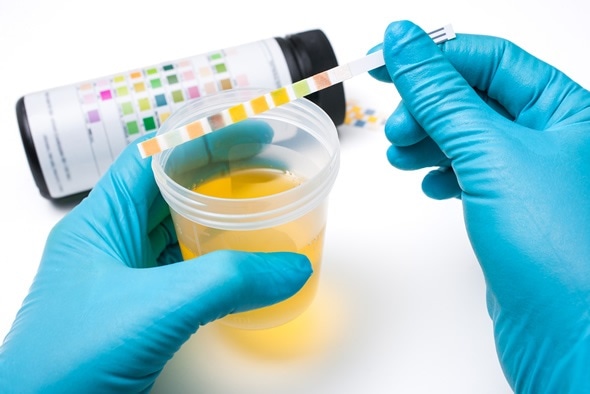Now Reading: Detection of Drug Abuse Through Urine Analysis
-
01
Detection of Drug Abuse Through Urine Analysis

Detection of Drug Abuse Through Urine Analysis
The menace of Drug Abuse is increasing at an alarming rate in the current scenario among the youngsters, so its high time to take some initiative. According to WHO, Drug Abuse also known as Substance Abuse defined as, “the harmful use of the psychoactive substance, including alcohol & illicit drugs”[1]. So, in layman language ‘drug abuse is the misuse or improper use of the drugs which are actually meant for curing/preventing illness or diseases’. Referring to the reports of NDDTC, commonly abused drugs are Cannabis, Opioids, Cocaine, LSD, Amphetamine etc, due to easy availability and of low cost. According to the Survey of Ministry of Social Justice & Empowerment Government Of India, drug abuse rate is 59%:[2] Magnitude of Substance Use in India 2019
FORENSIC ASPECT OF PREVENTING DRUG ABUSE
The main role of forensics to prevent drug abuse is by detecting the type of drugs that are in circulation among the youngsters. For the detection of the sample, collection, preservation, and analysis of the sample plays a crucial role. Generally, the Urine sample is regarded as the best sample among biological fluids but why? Because this sample is found in ample amount, detection can be up to several weeks, contains the parent metabolites and compounds concentration is very high, which can be used for the detection of drug type [3].
CASE STUDY
A 30year old lady (victim) complained about being raped in a massage parlor. The lady was told to give the full body massage service followed by the consumption of green tea and chocolate. The first occasion was uneventful and after the second, third-occasion she felt dizzy and discomfort due to the touch in the private parts but she was not in the state of denial because she had consumed a glass of wine prior to massage which was spiked. After 20hrs of complaint, a urine sample was collected for the forensic analysis. Urine analysis for the common illict drugs was done and the result was negative. Then the test for sedative triazolam was done using Ultra performance liquid chromatography coupled with mass spectrometry(UPLC-MS) and the result was positive with the presence of 39μ/l of the amount in it. The culprit accepted the fact of spiking the drink and raping. Using the urine sample analysis the case was solved [4].
DETECTION OF DRUGS IN URINE SAMPLE
l PRELIMINARY / SCREENING TEST: It is a type of qualitative test which is determined by the change in color. Basically an interaction between antigen and enzyme induced antibody(metabolites). Includes immuno-assay techniques, they are;
1. Enzyme multiplied immunoassay techniques(EMIT): It is the most easiest and cheap technique and results can be expected very soon. Many times it gives false-positive results.
2. Fluorescent polarization immunoassay technique(FPI): It is highly specific techniques as less chance of false-positive result can be expected and is highly sensitive in nature as it only binds to specific metabolites.
3. Radioimmunoassay(RIA): It is the most sensitive technique and is harmful because of the use of radio isotopes.
4. Thin Layer Chromatography: The metabolites get separated on a porous sheet which is dipped in a suitable solvent. It is a time-consuming process and cheap in nature. Though this technique is affordable in nature so it is used most frequently for detection. This technique can be used for the quantitative process as it separates metabolites into its constituents from which we can determine drug type and its composition nature.
|
DRUG |
TECHNIQUE |
CAN BE DETECTED UPTO |
|
MARIJUANA |
EMIT,RIA,FIA |
2-3days |
|
COCAINE |
EMIT,RIA |
48hours |
|
LSD |
RIA |
30hours |
|
AMPHETAMINE |
EMIT,Roche Abuscreen |
24hours |
|
OPIATES |
EMIT,Roche Abuscreen |
3days |
Screening test for Drugs of Abuse and their detection technique[5]
l CONFIRMATORY TEST: This is a quantitative test and accurate results are obtained because it is the most sensitive and specific test. After this test, the reports made are admissible for legal purpose. Drug type and metabolite concentration of drugs are more specific using this test so it is reliable in nature. Various test that are performed are
1. Gas-liquid chromatography(GLC): Metabolites that are present in the urine sample is run through a column and based on the result, it is compared with a control sample. This technique is less reliable as compared to other techniques due to its accuracy in terms of mass.
2. Gas chromatography/mass spectrometry(GC/MS): This is a standard technique for the identification of drugs and is very accurate in the result as compared to GLC.
3. High-performance liquid chromatography(HPLC): This is an advanced technique and with less error rate [6].
|
DRUG TYPE |
METABOLITES FOUND |
DETECTION TECHNIQUE |
DETECTED UPTO |
|
MARIJUANA |
9-carboxy-THC |
GLC,GC/MS |
1-3days |
|
COCAINE |
benzoylecgonine |
GC/MS,HPLC |
3days |
|
AMPHETAMINE |
Hippuric & benzoic acid |
GLC/NPD(Nitro phosphorous detector |
24hours |
|
LSD |
N-Demethyl 13-hydroxy |
GC/MS, HPLC |
30hours |
|
OPIATES |
Morphine-3-glucurnoid |
GLC, HPLC |
2-4days |
Confirmatory test for Drug of Abuse, their metabolites, and detection time [7].
ALTERNATIVE METHOD OF DETECTION
Ø The methods that are discussed above are time-consuming methods. Due to an increase in cases from day to day, it has become necessary to upgrade with the techniques. With the invention of the rapid test kit, the problem has sought. These rapid test kit detects the Substance of Abuse immediately and can also detect the adulteration with the sample with the help of a thermometer to check the temperature of some additives [8].
Ø Using these techniques various cases can be solved without any delay. In some cases, there might be a possibility of getting dried urine spot(DUS), in these cases using the method of Liquid chromatography-Mass Spectrometry (LC-MS) [9].
Ø Certain laboratories report about the urine creatinine which helps to determine the concentration the or dilution of the urine. If a person takes water prior to sample collection creatinine level will be more which means dilution state. So, which analyzing for drugs concentration creatinine level should be check to avoid false-positive result [10].
Like every coin has a head and tail side similarly every techniques have some advantages and disadvantages. In this context, a urine sample is generally regarded for the analysis of drug metabolites because it is available easily in large amounts, can be preserved easily and parent metabolites concentration is high as compared to another matrix. While on the other side, the chance of adulteration is more due to the collection procedure and the sample may be degraded if not preserved in ambient condition and temperature. With an increase in the use of the drug, it has become necessary to take quick and strict actions to prevent the spread of abusing drugs among youngsters and make detection easier and faster.
REFERENCES
1. World Health Organization (WHO) Health topics. Retrieved from https://www.who.int/topics/substance_abuse/en/
2. Ministry of Social Justice and Empowerment Government of India. Magnitude of Substance Use in India (2019).Retrieved from : https://www.aiims.edu/images/pdf/Departments_Centers/NDDTC/Magnitude_Substance_Use_India_REPORT
3. Pizzolato,T.M.,Lopes de Alda,M.J.,Barcelo.D.(April 24,2007). LC-based analysis of drugs of abuse and their metabolites in urine. Science Direct. https://doi.org/10.1016/j.trac.2007.04.005
4. Johansen,S.S.,& Sorensen,R.D.(2012). A Drug Rape Case Involving Triazolam Detected in Hair and Urine. International Journal of Legal Medicine. Pubmed. DOI: 10.1007/s00414-011-0654-6
5. Schwartz,R.H.(November 1988).Urine Testing in the Detection of Drugs of Abuse. Jama network. Arch Intern Med. 1988;148(11):2407-2412. doi:10.1001/archinte.1988.00380110059012
6. Center for Substance Abuse Treatment. Substance Abuse: Clinical Issues in Intensive Outpatient Treatment. Rockville (MD): Substance Abuse and Mental Health Services Administration (US); 2006. (Treatment Improvement Protocol (TIP) Series, No. 47.) Appendix B. Urine Collection and Testing Procedures and Alternative Methods for Monitoring Drug Use. Available from: https://www.ncbi.nlm.nih.gov/books/NBK64092/.
7. Hawks,R.L.,NoraChiang,D.C.(1986). Urine Testing for Drugs of Abuse. National Institute of Drug Abuse NIDA Monograph 73. https://archives.drugabuse.gov/sites/default/files/monograph73.pdf
8. Al-Khayal,R.A.,Al Monsa,F.A.,Attia,A.M.,Ragab,A.R.(2017). Efficiency Evalution of Urine Collection Vessels with impeded Urine Adulteration/Substance of Abuse(SOA) Rapid Detection Test Strips. Journal of Drug Abuse. DOI:10.21767-853X.100051
9. Jain.R.,Quraishi.r,Verma.A.,Ambekar.A.(2019). Development and Clinical Evaluation of a Dried Urine Spot Method for Detection of Morphine Among Opioid Users. Indian Journal of Pharmacology. DOI: 10.4103/ijp.IJP_305_18
10. Handland,S.E.,Levey,S.(2016).OBJECTIVE TESTING – URINE AND OTHER DRUG TESTS. doi: 10.1016/j.chc.2016.02.005
Author
Pallavi Mohanty
Intern at Dept. of Forensic Science & Criminal Investigation
Legal Desire Media & Insights









